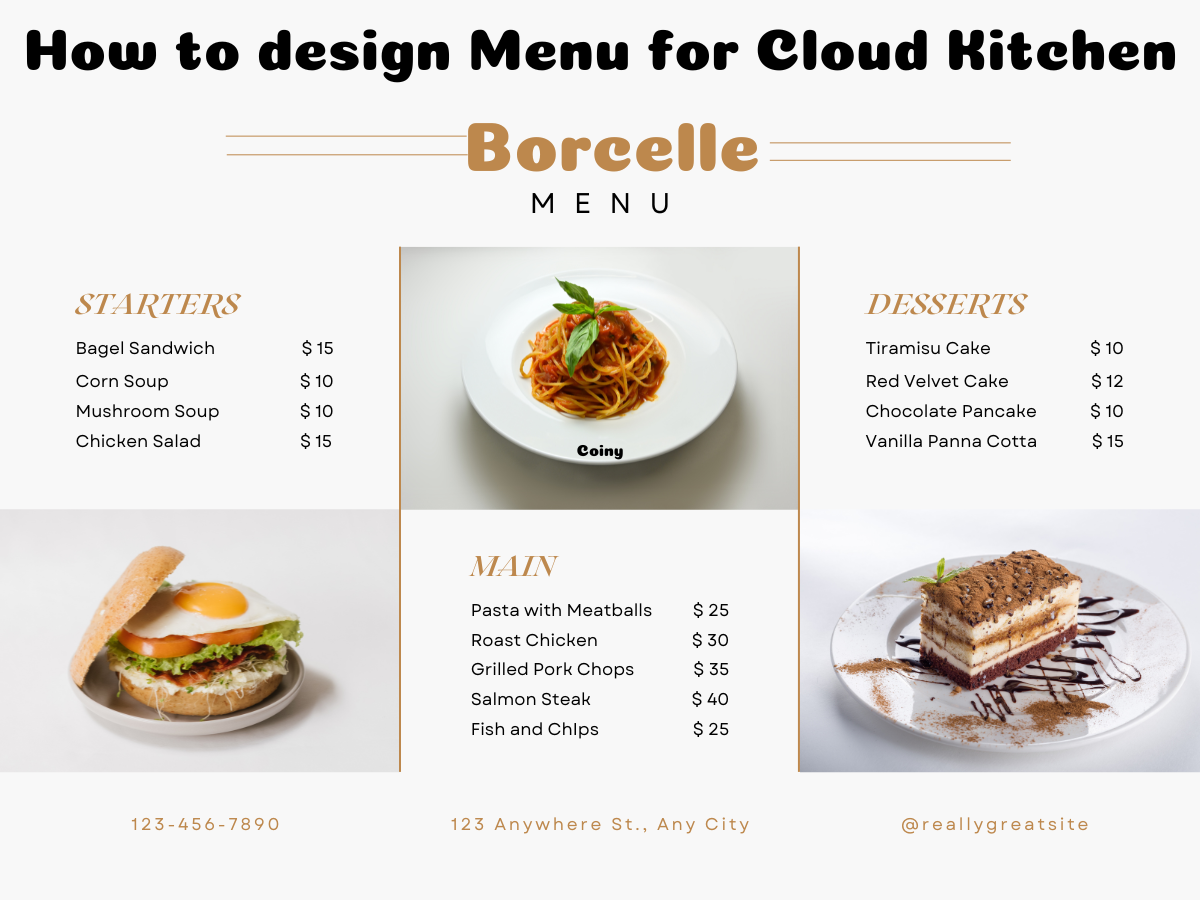How to design a Menu for cloud kitchen
1. Introduction: – How to design a Menu for cloud kitchen
Hi friends, My name is Sushil Singh, and again, welcome to the Aadi Blog. At this blog, we will talk about how to create a Menu for Cloud Kitchen. If you are the owner of a cloud kitchen or want to open one and try to find the answer to this question, then this article is the perfect place for you. Creating the right menu list is the cornerstone of cloud kitchens.
We’ll learn about it step-by-step and watch some other important aspects of menu design. Creating a menu table not only selecting the right dishes on your menu but also strategically selecting offerings that tempt, satisfy, and retain customers with your brand. At this time, when food delivery is on the rise, a well-designed menu will work for it and attract every person with a delicious dish.
Furthermore, creating a Menu for Cloud Kitchen depends on many factors. That factors can be market trends, targeted customers, ingredient availability, and operational efficiency. A thoughtfully created menu not only shows the identity of your cloud kitchen but also serves as a roadmap for profitability and customer satisfaction.
2. Understanding Your Audience
Creating a Menu for Cloud Kitchen based on your cloud kitchen’s customers is very important. First, you should decide which type of people your targeted customers are; those could be health-conscious people or busy professionals. You can analysing customer preferences and dietary trends. You start researching popular dishes, dietary restrictions, and emerging food trends.
You should conduct surveys and study the available data from cloud kitchens to gain insights. According to the results of tests, you can know the dietary habits of your potential customers.
If you know your customers, then you can customise your menu to meet their specific needs and preferences. First, You make sure that your cloud kitchen attracts loyal customers. You should make your menu according to the tastes and preferences of your target customers.
3. Defining Your Concept
When you decide to create a Menu for Cloud Kitchen, it is necessary that your menu be according to your cloud kitchen concept. A well-designed menu card defined everything about Cloud Kitchen. For a good concept, you need to choose a good culinary theme and style for your cloud kitchen that will set your kitchen apart from other cloud kitchen brands.
Before concept planning, you should consider the preferences of your target customers and market trends to guide your choices. Whether you are focusing on fast food, sweets, or healthy food options, your first priority should be your customers taste. Your menu should align with your brand identity, values, and aspects of your customers.
Everything connected with your brand, like ingredients, the presentation of your dishes, and every little aspect, should reflect your brand’s personality and goals. Your menu will match with your concept and brand ideology, you’ll not only attract customers but also build loyal followers who will appreciate the consistency and authenticity of your offerings.
4. A Menu Development Process
Making an appealing Menu for Cloud Kitchen is key to success. If you want to create an attractive menu for your cloud kitchen, then these processes start with detailed market research, emerging cooking trends and exploring consumer preferences.
If you know about the market and understand its direction, then you can easily identify popular dishes and forecast customer demands. It’s necessary to create a balanced Menu for Cloud Kitchen brand. This menu should offer a variety of options to cater to various tastes and dietary preferences and attract customers.

You should strike the right balance between innovation and customer preferences. With this balance, your cloud kitchen brand can effectively capture the attention and loyalty of customers in a competitive landscape.
5. Optimising for delivery
When you create a Menu for Cloud Kitchen, it should be optimised for your delivery location. When you choose the item for the menu, you carefully select menu items that are not only good in taste but also withstand the journey to the customer’s doorstep.
Choose dishes that can be easily delivered, such as those with sturdy ingredients or minimal sauces prone to leakage. So packaging plays an important role in maintaining freshness and presentation. Investing in durable, eco-friendly packaging that keeps food hot and prevents spills can elevate the customer experience.
If you consider using aesthetic packaging, it contributes to the overall presentation and enhances the perceived value of the meal. In an increasingly competitive market, cloud kitchen owners can ensure customer satisfaction and loyalty by prioritizing menu items that excel at delivery and applying thoughtful packaging solutions.
6. Menu Layout and Design
When you start to create a Menu for Cloud Kitchen, you can involve more than just listing dishes; it’s about creating an immersive culinary experience.
Menu layout and design play a crucial role in appealing to customers and guiding their ordering journey consistently. A cloud kitchen owner can start by designing a visually appealing layout that is both aesthetically pleasing and easy to navigate.
Organise dishes into logical categories, ensuring customers can quickly find what they’re looking for. Use descriptive language for dishes; vividly describe each dish’s flavours, ingredients, and preparation methods. Connecting descriptions with appealing imagery further enhances the dining experience, allowing customers to envision the dish before ordering.
Use of high-quality images can significantly impact on customers’ decision-making processes. During the menu-making process, you can use both layout and descriptive elements. Your cloud-based kitchen menu becomes a powerful tool for attracting and satisfying customers.
7. Pricing Strategy
You need a strategic approach for menu creation in the cloud kitchen business, particularly in terms of pricing. The pricing strategy is important for ensuring profitability and competition. It’s necessary to consider the right balance between being competitive and ensuring profitability.
The cloud kitchen owner should analyse the price according to the quality of similar items on the market. During the analysis, also consider factoring in costs to ensure a reasonable profit margin. Moreover, the cloud kitchen owner should implement pricing tiers according to the budget of customers and give a wide range of customers.
You can give some offers to customers, like special deals, combo deals, and discounts. These types of deals help you attract loyal customers and increase your profit level. Finally, a well-planned pricing strategy will not only attract customers but also ensure the continuity and profitability of the cloud kitchen.
8. Menu Testing and Feedback
In the region of cloud kitchens, you should know all about cloud kitchens, like customer thoughts, feedback, and which items are most liked on the menu. Menu testing and feedback are more important in this journey because they will decide the future of the cloud kitchen.
The process starts with the analysis of customer orders and feedback. You can invite people to a taste test and get their feedback. Because of this, you will learn about the preferences of customers. This initial step works as the cornerstone of the menu and needs to be refined. It’s also important to make sure that the menu attracts the right kind of people.
Analysing feedback allows you to make adjustments to the menu, whether it’s tweaking flavours, adjusting dish sizes, or introducing new dishes. In the competitive landscape of cloud kitchens, an attractive and delicious food menu always attracts customers because it evolves with customer tastes, increases satisfaction levels, and drives business growth.
9. Promotion and Marketing
After the menu-making process, you need a powerful promotion and marketing plan; it’s essential. Start this process by developing marketing strategies customised according to your target customers.
Utilise social media platforms and other digital channels to create buzz and engage with potential customers. If you want to know how to use social media, you can read our detailed blog, “Leveraging Social Media to Grow Your Cloud Kitchen Brand.“
Think about running promotional campaigns and offering discounts or special deals to attract new customers. You can collaborate with food influencers or local bloggers to extend your reach and credibility.
Also, ask your customers for feedback so that you can improve your food and marketing over time. You can attract customers and build a strong presence in the competitive cloud kitchen market by carefully advertising the launch of your new menu.
10. Menu Evolution and Adaptation
Making a Menu for Cloud Kitchen is more than just naming dishes; it’s an active process that changes and grows over time. Cloud kitchen owners should look at the market in every way, whether it’s to see what customers want, get comments, or see what food trends are happening.
Look at what people order to see how popular your foods are. You should figure out which dishes aren’t selling well or aren’t popular, and then swap them out for new dishes that are. Based on what people want, you should make the food list better. These constant tweaks make sure that the food always reflects the mood of the market and meets customers’ changing needs.
By using this plan, cloud kitchens not only stay current, but they also make a name for themselves in the very competitive world of food, offering customers a wide range of tempting choices that suit their changing tastes.
11. Sustainability and Dietary Considerations
It’s important for you to think about sustainability and dietary needs when making a meal for a cloud kitchen. To ensure sustainability in this journey, purchase locally grown or raised food, minimise food waste, and opt for eco-friendly packaging.
You should add people-friendly options to your menu. You may add different types of dishes that meet a lot of needs, like those who are vegetarian, vegan, non-vegetarian, or gluten-free. You can get more customers and keep health-conscious customers coming back by catering to different dietary needs and limits, like keto, paleo, or low-sodium diets.
You should strike a good balance between sustainability and accommodating different diets. That balance will help you improve the brand’s image, and like this, you will also make the food service business more eco-friendly and socially responsible.
12. Staff Training and Menu Knowledge
For a cloud kitchen, making a good Menu for Cloud Kitchen is more than just naming dishes. “Staff Training and Menu Knowledge” is very important.
You should start by giving your team thorough training. Teach your staff about the food items, including what’s in them and how to make them. It gives them the confidence to answer customer questions correctly and with confidence.
In cloud kitchens, consistency is very important, so make sure that all meals are cooked the same way and that customer service standards are kept high. Staff who are well-trained and know a lot about the menu not only make the meal better, but they also help the kitchen’s general reputation and efficiency.
13. Conclusion
Last but not least, making a meal for a cloud kitchen needs a lot of planning and thought. Knowing your target audience, doing market research, and making food items work better for delivery are all important things that this blog has talked about.
Making sure your menu has a lot of options, is quick, and is easy to use will help you make the most money and meet the needs of the digital market. To keep your food fresh, review it often and make changes based on what your customers say and how trends change. You should be able to make a plan that not only meets the needs of your customers but also helps your cloud cooking business grow with the help of this guide.
Let yourself be artistic, try out different combinations, and most of all, be flexible so you can change with the business. You are about to begin your journey to becoming a great chef in the cloud. Get ready to make plans and cook!

